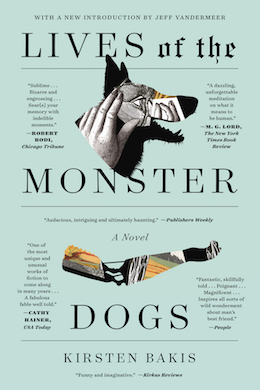It’s been twenty years since Kirsten Bakis’s novel Lives of the Monster Dogs was first released. It wasn’t long after that that I first caught sight of its spine in a bookstore somewhere–probably either the Union Square Barnes & Noble or St. Marks Bookshop, both of which I frequented in the late ’90s and early 2000s. I don’t think I need to explain why the book caught my eye: its title is, after all, Lives of the Monster Dogs. And, as the back cover explained, that was not intended metaphorically: many of the characters of this novel are, in fact, dogs. Sentient dogs who walk upright and use prostheses to manipulate objects. (The image on the cover of the original paperback edition featured a wolflike figure wearing an elegant robe and using a cane.) So: a surreal and speculative story, along with provocative questions about what makes us human. What’s not to like?
After an initial rush of acclaim, Bakis’s novel has been out of print for a few years ago, which makes this reissue a particularly welcome occurrence. In his introduction to this new edition, Jeff VanderMeer notes that its contemporaries included the likes of Don DeLillo’s Underworld. He also positions it in a particular place within literature: “The brilliance of the approach, and its bravery, is that Bakis wants to show you not just what happened on her version of the island of Dr. Moreau, so to speak, but the aftermath.”
The novel opens with a nearly perfect first line: “In the years since the monster dogs were here with us, in New York, I’ve often been asked to write something about the time I spent with them.” Writing here is Cleo Pira, one of the novel’s two narrators; in the span of this one sentence, Bakis establishes several things: that there were dogs that walked among men, that the narrator here was close to them, and that that period of time has drawn to a close. Soon enough, more specifics emerge: “it’s been over six years since they were here,” Cleo writes. Her narrative is presented as the introduction to (and commentary on) a document written by a dog historian named Ludwig von Sacher. And it’s dated October 2017—still a version of the future, even now.
From Cleo’s preface, we move to Ludwig’s prologue, dated 2009—and immediately, Bakis does the subtle work in making the voices of her two narrators feel distinct. Ludwig’s text takes a more elegiac tone—in the second paragraph, he alludes to “an illness, or psychological disorder which comes on periodically and may soon prevent me from working.” His approach is moodier, more contemplative; slowly piecing together the nature of words and memory and time. But then, in this fictional work, that makes sense: his historical text and Cleo’s historical text have different roles to play in the overall book. Ludwig provides the historical context—including the monster dogs’ origin in the theories of a 19th-century Prussian scientist—while Cleo acts as a surrogate for the reader, providing an sense of the human perspective, and a sense of wonder.
Found documents tell part of the story as well. In quick succession, via a news article, the dogs’ Germanic names are explained, as is the source of their wealth (via the accumulation of now-rare coins). The journal of Augustus Rank, the man responsible for the origin of these highly evolved canines, also appears within the text. As VanderMeer’s introduction suggests, the story hearkens back to an early kind of scientific horror—Rank’s obsessive pursuit of science takes him to surreal and unsettling places, and puts him firmly in the pantheon of Doctors Moreau and Frankenstein. (The original New York Times review also suggested Mikhail Bulgakov’s Heart of a Dog and the works of Robertson Davies as reference points—in other words, Bakis is in idiosyncratic territory here.) But there’s also a decidedly modern component to the story Bakis is telling, both through its nods to celebrity culture and the way that the dogs increasingly ponder their mortality, both due to their lifespans and due to the illness Ludwig alludes to early in the book.
In Cleo’s preface, she gives a sense of the place of her work in the larger culture. “Even now, we’re still inundated with books, movies, and documentaries about the monster dogs,” she writes. It’s a kind of alternate near-present, one in which humanity was confronted with its own mirror, and in which the thinking creatures that humanity created were forced to deal with the questions of their own existence. It’s a classically speculative setup, and Bakis thoroughly grapples with the philosophical and moral questions raised by this premise. That her characters are vividly drawn, and her version of New York feels eminently plausible, are also laudable aspects of this book. It’s a welcome return to print for a haunting book, both for its thought-provoking premise and the moving events it encompasses.
Lives of the Monster Dogs 20th Anniversary Edition is available now from Farrar, Strauss & Giroux.
 Tobias Carroll is the managing editor of Vol.1 Brooklyn. He is the author of the short story collection Transitory (Civil Coping Mechanisms) and the novel Reel (Rare Bird Books).
Tobias Carroll is the managing editor of Vol.1 Brooklyn. He is the author of the short story collection Transitory (Civil Coping Mechanisms) and the novel Reel (Rare Bird Books).










